Organizational Change Management: Literature Review and Critique
VerifiedAdded on 2021/06/17
|13
|3083
|59
Report
AI Summary
This report provides a comprehensive literature review on organizational change management, focusing on the critical issue of employee resistance to change. The study examines various factors contributing to resistance, such as job insecurity, lack of control, and the impact of strict rules. It explores effective strategies for managing resistance, including clear communication, employee participation, supportive leadership, and the importance of organizational climate. The report analyzes the roles of different leadership styles (transformational and transactional) and organizational structures in facilitating change. The review also includes critiques of the selected articles, evaluating their strengths, weaknesses, and research methodologies. The report emphasizes the significance of employee perception, justice, and relationships with supervisors in the successful implementation of organizational change. The report highlights how organizations can adopt strategies for effective change management to navigate evolving business environments.
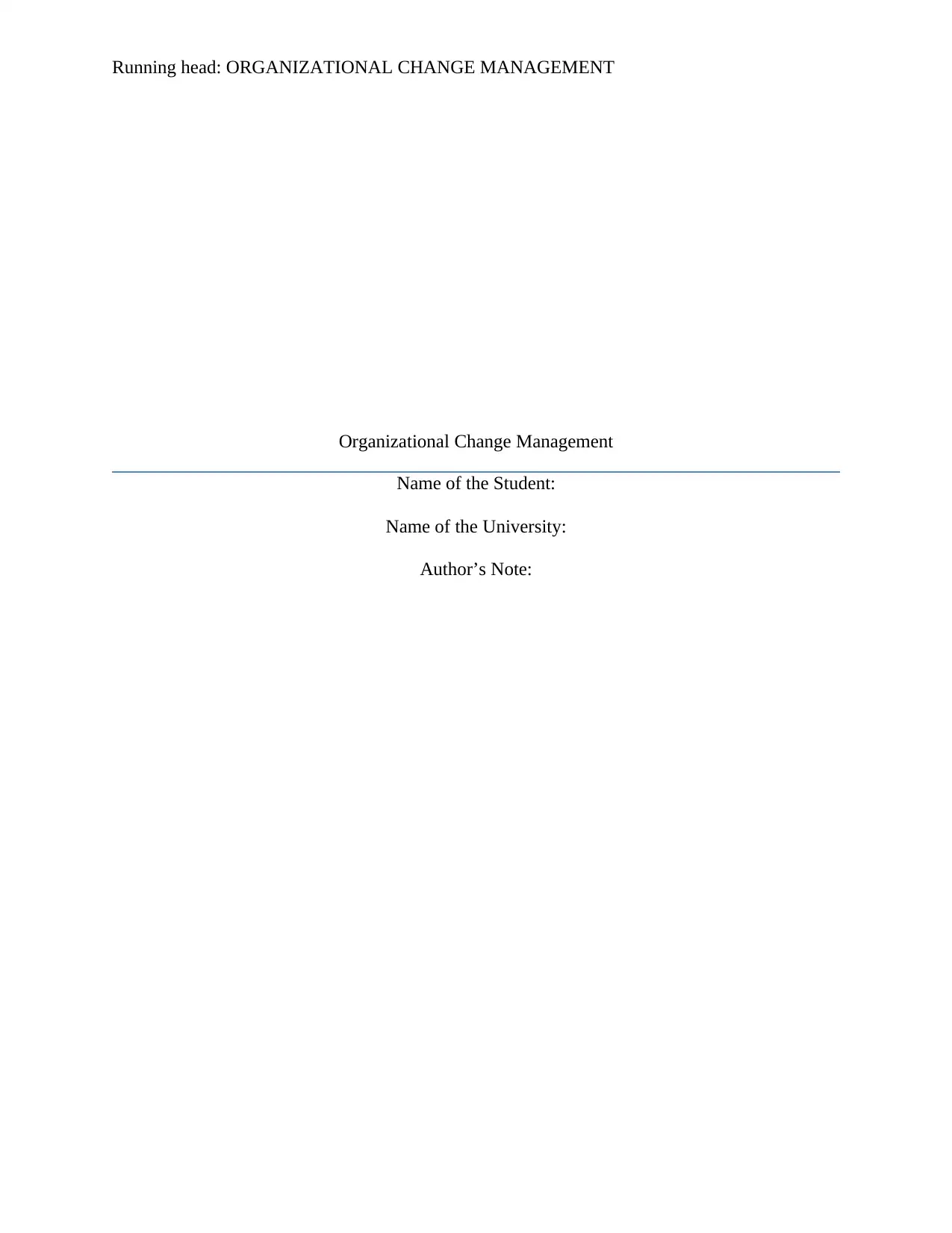
Running head: ORGANIZATIONAL CHANGE MANAGEMENT
Organizational Change Management
Name of the Student:
Name of the University:
Author’s Note:
Organizational Change Management
Name of the Student:
Name of the University:
Author’s Note:
Paraphrase This Document
Need a fresh take? Get an instant paraphrase of this document with our AI Paraphraser

1ORGANIZATIONAL CHANGE MANAGEMENT
Table of Contents
Introduction......................................................................................................................................2
Part A: Literature Review................................................................................................................2
Part B: Critique of Literature...........................................................................................................7
Reference List................................................................................................................................11
Table of Contents
Introduction......................................................................................................................................2
Part A: Literature Review................................................................................................................2
Part B: Critique of Literature...........................................................................................................7
Reference List................................................................................................................................11

2ORGANIZATIONAL CHANGE MANAGEMENT
Introduction
Organizational change management is the framework of managing the effect of new
business process, organizational structure and cultural change within an organization. Resistance
of employees towards accepting the change has been considered as the most significant reason of
the failure of resistance to change. This study will construct a literature review on the topic of
Managing Resistance to Change. The study will choose 10 articles for constructing the overall
literature review. Apart from that, the study will also make critique of the literature review.
Part A: Literature Review
Over the years, various authors have conducted research on the reasons behind failure of
organizational change. Most of the researches have indicated employee resistance to change as
the most significant reason behind the failure of change. According to Georgalis et al. (2015),
employee perception of justice arising from positive perception of change and positive
employee-supervisor relation significantly reduces the negativity of changes. Most of the
employees are likely to resist the organizational changes due to their job insecurity, loss of
control over their jobs and increasing job burden. In such situation, effective employee-
supervisor relation with proper information dissemination and employee participation leads to
positive employee perception of justice. Moreover, cooperative leader member exchange,
employee participation in change process and transparent information dissemination can assist
the managers in managing the resistance to change.
The employees are mostly resistant to organizational changes, when they are imposed
with strict rules and regulations towards accepting the changes. Sanagustin (2014) opined that
Introduction
Organizational change management is the framework of managing the effect of new
business process, organizational structure and cultural change within an organization. Resistance
of employees towards accepting the change has been considered as the most significant reason of
the failure of resistance to change. This study will construct a literature review on the topic of
Managing Resistance to Change. The study will choose 10 articles for constructing the overall
literature review. Apart from that, the study will also make critique of the literature review.
Part A: Literature Review
Over the years, various authors have conducted research on the reasons behind failure of
organizational change. Most of the researches have indicated employee resistance to change as
the most significant reason behind the failure of change. According to Georgalis et al. (2015),
employee perception of justice arising from positive perception of change and positive
employee-supervisor relation significantly reduces the negativity of changes. Most of the
employees are likely to resist the organizational changes due to their job insecurity, loss of
control over their jobs and increasing job burden. In such situation, effective employee-
supervisor relation with proper information dissemination and employee participation leads to
positive employee perception of justice. Moreover, cooperative leader member exchange,
employee participation in change process and transparent information dissemination can assist
the managers in managing the resistance to change.
The employees are mostly resistant to organizational changes, when they are imposed
with strict rules and regulations towards accepting the changes. Sanagustin (2014) opined that
⊘ This is a preview!⊘
Do you want full access?
Subscribe today to unlock all pages.

Trusted by 1+ million students worldwide
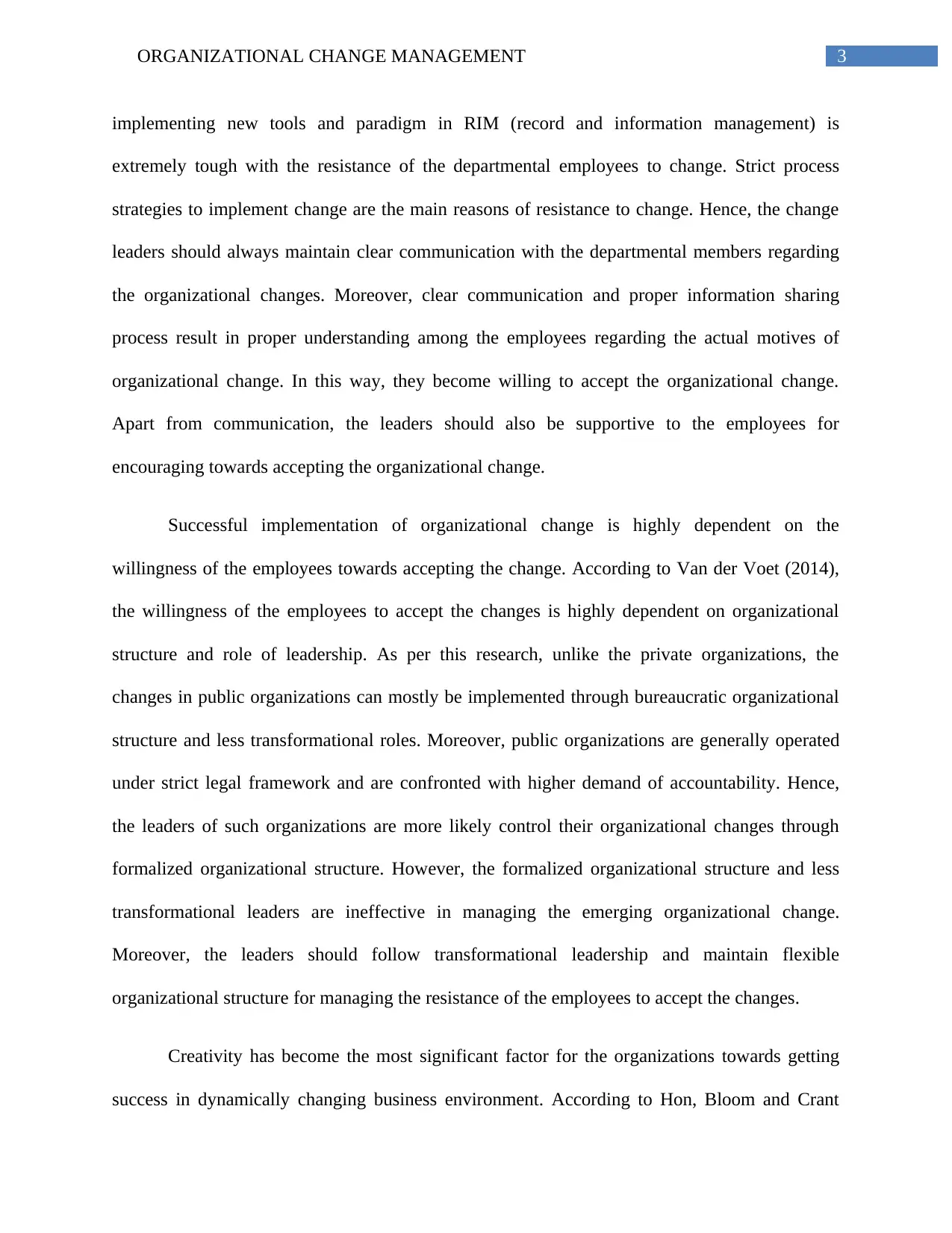
3ORGANIZATIONAL CHANGE MANAGEMENT
implementing new tools and paradigm in RIM (record and information management) is
extremely tough with the resistance of the departmental employees to change. Strict process
strategies to implement change are the main reasons of resistance to change. Hence, the change
leaders should always maintain clear communication with the departmental members regarding
the organizational changes. Moreover, clear communication and proper information sharing
process result in proper understanding among the employees regarding the actual motives of
organizational change. In this way, they become willing to accept the organizational change.
Apart from communication, the leaders should also be supportive to the employees for
encouraging towards accepting the organizational change.
Successful implementation of organizational change is highly dependent on the
willingness of the employees towards accepting the change. According to Van der Voet (2014),
the willingness of the employees to accept the changes is highly dependent on organizational
structure and role of leadership. As per this research, unlike the private organizations, the
changes in public organizations can mostly be implemented through bureaucratic organizational
structure and less transformational roles. Moreover, public organizations are generally operated
under strict legal framework and are confronted with higher demand of accountability. Hence,
the leaders of such organizations are more likely control their organizational changes through
formalized organizational structure. However, the formalized organizational structure and less
transformational leaders are ineffective in managing the emerging organizational change.
Moreover, the leaders should follow transformational leadership and maintain flexible
organizational structure for managing the resistance of the employees to accept the changes.
Creativity has become the most significant factor for the organizations towards getting
success in dynamically changing business environment. According to Hon, Bloom and Crant
implementing new tools and paradigm in RIM (record and information management) is
extremely tough with the resistance of the departmental employees to change. Strict process
strategies to implement change are the main reasons of resistance to change. Hence, the change
leaders should always maintain clear communication with the departmental members regarding
the organizational changes. Moreover, clear communication and proper information sharing
process result in proper understanding among the employees regarding the actual motives of
organizational change. In this way, they become willing to accept the organizational change.
Apart from communication, the leaders should also be supportive to the employees for
encouraging towards accepting the organizational change.
Successful implementation of organizational change is highly dependent on the
willingness of the employees towards accepting the change. According to Van der Voet (2014),
the willingness of the employees to accept the changes is highly dependent on organizational
structure and role of leadership. As per this research, unlike the private organizations, the
changes in public organizations can mostly be implemented through bureaucratic organizational
structure and less transformational roles. Moreover, public organizations are generally operated
under strict legal framework and are confronted with higher demand of accountability. Hence,
the leaders of such organizations are more likely control their organizational changes through
formalized organizational structure. However, the formalized organizational structure and less
transformational leaders are ineffective in managing the emerging organizational change.
Moreover, the leaders should follow transformational leadership and maintain flexible
organizational structure for managing the resistance of the employees to accept the changes.
Creativity has become the most significant factor for the organizations towards getting
success in dynamically changing business environment. According to Hon, Bloom and Crant
Paraphrase This Document
Need a fresh take? Get an instant paraphrase of this document with our AI Paraphraser

4ORGANIZATIONAL CHANGE MANAGEMENT
(2014), organizational change is the most essential and integral part of organizational creativity
that involves organizational adoption and growth. However, the employees are typically resistant
to change because of their preference to maintain current status quo and fear of job insecurity. In
such situation, the dogmatic and close minded employees are more likely to participate in the
organizational change process, when the organizational leaders and organizational climate are
supportive to them in accepting the organizational changes. Moreover, the leaders should clearly
communicate the information about change to the employees and allow them freely in
participating in the change process. On the other hand, the adequate support from the co-workers
also helps in managing the resistance to change.
Technological industry is more likely to face changes due to changing complex
technology, diversified workforce and disoriented strategies. However, the employees are always
resistant to accept the changes and show less commitment in the change process. As per
Wadood, Gharleghi and Samadi (2016), effective leadership and management strategy are highly
significant in managing the resistance of the employees towards implementing successful
changes. Moreover, the managers of organizations in technological industry should implement
new policies and procedures towards changing the attitude and behavior of the employees
towards the change process. On the other hand, transactional leadership has been proved to be
more effective in managing the changes rather than transformational leaders. Moreover,
transformational leaders are more effective in enhancing the organizational commitment of
employees, but not the change commitment.
In contemporary business organizations, the leaders navigate an ever-accelerating change
in technology, standards, mobility, cultural value and global economy. However, the
organizational leaders more often face difficulties in implementing the organizational changes
(2014), organizational change is the most essential and integral part of organizational creativity
that involves organizational adoption and growth. However, the employees are typically resistant
to change because of their preference to maintain current status quo and fear of job insecurity. In
such situation, the dogmatic and close minded employees are more likely to participate in the
organizational change process, when the organizational leaders and organizational climate are
supportive to them in accepting the organizational changes. Moreover, the leaders should clearly
communicate the information about change to the employees and allow them freely in
participating in the change process. On the other hand, the adequate support from the co-workers
also helps in managing the resistance to change.
Technological industry is more likely to face changes due to changing complex
technology, diversified workforce and disoriented strategies. However, the employees are always
resistant to accept the changes and show less commitment in the change process. As per
Wadood, Gharleghi and Samadi (2016), effective leadership and management strategy are highly
significant in managing the resistance of the employees towards implementing successful
changes. Moreover, the managers of organizations in technological industry should implement
new policies and procedures towards changing the attitude and behavior of the employees
towards the change process. On the other hand, transactional leadership has been proved to be
more effective in managing the changes rather than transformational leaders. Moreover,
transformational leaders are more effective in enhancing the organizational commitment of
employees, but not the change commitment.
In contemporary business organizations, the leaders navigate an ever-accelerating change
in technology, standards, mobility, cultural value and global economy. However, the
organizational leaders more often face difficulties in implementing the organizational changes

5ORGANIZATIONAL CHANGE MANAGEMENT
due to resistance of the employees towards accepting the changes. Ineffective co-ordination in
the organizational change process can lead to failure in the organizational changes. Wilson
(2014) opined that the organizational leaders must develop unified and clear change strategy and
approach for communication and driving intended organizational changes. Clear communication
helps the employees to under the actual intension behind the intended organizational change. On
the other hand, high level of employee participation in the change management process reduces
their level of uncertainty with the organizational change. Hence, it becomes easier for the
managers to convincing the employees in accepting the changes.
Merger leads to changes in the cultural aspects of an organization. Merger entails the
destruction previous organizational culture and reconstruction of new organizational culture. As
per Barratt-Pugh and Bahn (2015), the organizational culture changes during merger lead to
emotional confusion among the employees and traumas displaced among the employees. Hence,
the employees are more likely to resist to such changes leading to failure of overall
organizational changes. In such situation, traditional hard human resource management is
ineffective to alter the behavior, attitude, values and norms of the employees towards accepting
the new changes. On the other hand, soft human resource management facilitates the employee
engagement with new norms, values and changing organizational behavior in the change process.
Owner organizations in construction, engineering and architecture industry are more
likely to face changes for contracting, procuring and others. However, project team resistance
becomes the most significant hindrance for the changes in such organization. According to Lines
et al. (2015), unrealistic expectation in changes that underestimates the amount of effort and time
needed to accomplish the changes may lead to resistance to the change. Moreover, the change
agents assigns the change responsibility in such a way that they become accountable for the
due to resistance of the employees towards accepting the changes. Ineffective co-ordination in
the organizational change process can lead to failure in the organizational changes. Wilson
(2014) opined that the organizational leaders must develop unified and clear change strategy and
approach for communication and driving intended organizational changes. Clear communication
helps the employees to under the actual intension behind the intended organizational change. On
the other hand, high level of employee participation in the change management process reduces
their level of uncertainty with the organizational change. Hence, it becomes easier for the
managers to convincing the employees in accepting the changes.
Merger leads to changes in the cultural aspects of an organization. Merger entails the
destruction previous organizational culture and reconstruction of new organizational culture. As
per Barratt-Pugh and Bahn (2015), the organizational culture changes during merger lead to
emotional confusion among the employees and traumas displaced among the employees. Hence,
the employees are more likely to resist to such changes leading to failure of overall
organizational changes. In such situation, traditional hard human resource management is
ineffective to alter the behavior, attitude, values and norms of the employees towards accepting
the new changes. On the other hand, soft human resource management facilitates the employee
engagement with new norms, values and changing organizational behavior in the change process.
Owner organizations in construction, engineering and architecture industry are more
likely to face changes for contracting, procuring and others. However, project team resistance
becomes the most significant hindrance for the changes in such organization. According to Lines
et al. (2015), unrealistic expectation in changes that underestimates the amount of effort and time
needed to accomplish the changes may lead to resistance to the change. Moreover, the change
agents assigns the change responsibility in such a way that they become accountable for the
⊘ This is a preview!⊘
Do you want full access?
Subscribe today to unlock all pages.

Trusted by 1+ million students worldwide

6ORGANIZATIONAL CHANGE MANAGEMENT
change implementation success. Furthermore, the change agents can become effective guiding
force for the employees and support them to help in their struggle of accepting the organizational
changes. In this way, the positive personal relationship of the employees with the supervisor can
encourage the employees to accept the changes. Hence, adequate support and collaborative
relationship can assist the managers in managing the resistance to change.
Organizations must rapidly react to the rapidly evolving business environments through
initiating changes. Such changes can be from minor changes to radical transformation.
Resistance to change is the most significant factor that hinders the ultimate success of
organizational changes. As per Appelbaum et al. (2015), the organizations should reduce the
hierarchical distance among the employees for fostering successful organizational change.
Moreover, the organizational changes originated at the top management should be implemented
among all employees at all hierarchical level. On the other hand, the top level should properly
convey the trustworthy and change related information among the employees. It will build trust
among the employees regarding the organizational changes. Both transformational as well as
transactional leadership are extremely important for leading organizational changes by
highlighting roles, responsibilities, goals and vision among the employees. Moreover, such
leaders play critical role to shape the attitude and perception of the employees to accept the
organizational changes.
With the advancement in technology, most of the organizations are adopting CRM
technology for better interaction with the customers. However, resistance from the employees
can lead to failure of organizational change in adoption of these technologies. Reddick (2011)
stated that e-Government paradigm is more likely to impact on the organizational change than
the bureaucratic paradigm. Effective leadership and management help the organizational
change implementation success. Furthermore, the change agents can become effective guiding
force for the employees and support them to help in their struggle of accepting the organizational
changes. In this way, the positive personal relationship of the employees with the supervisor can
encourage the employees to accept the changes. Hence, adequate support and collaborative
relationship can assist the managers in managing the resistance to change.
Organizations must rapidly react to the rapidly evolving business environments through
initiating changes. Such changes can be from minor changes to radical transformation.
Resistance to change is the most significant factor that hinders the ultimate success of
organizational changes. As per Appelbaum et al. (2015), the organizations should reduce the
hierarchical distance among the employees for fostering successful organizational change.
Moreover, the organizational changes originated at the top management should be implemented
among all employees at all hierarchical level. On the other hand, the top level should properly
convey the trustworthy and change related information among the employees. It will build trust
among the employees regarding the organizational changes. Both transformational as well as
transactional leadership are extremely important for leading organizational changes by
highlighting roles, responsibilities, goals and vision among the employees. Moreover, such
leaders play critical role to shape the attitude and perception of the employees to accept the
organizational changes.
With the advancement in technology, most of the organizations are adopting CRM
technology for better interaction with the customers. However, resistance from the employees
can lead to failure of organizational change in adoption of these technologies. Reddick (2011)
stated that e-Government paradigm is more likely to impact on the organizational change than
the bureaucratic paradigm. Effective leadership and management help the organizational
Paraphrase This Document
Need a fresh take? Get an instant paraphrase of this document with our AI Paraphraser

7ORGANIZATIONAL CHANGE MANAGEMENT
members towards accepting the new changes. Furthermore, supportive leadership also helps the
managers in managing the resistance to changes occurred from implementing new CRM
technology.
Part B: Critique of Literature
The article written by Georgalis et al. (2015) has perfectly analyzed the importance of
employee perception in the process of organizational change management. However, the
hypotheses designed for the organization are less focused on designing strategies for overcoming
the resistance. The article has successful elaborated the employee supervisor relationship in the
building positive employee perception regarding the change. On the other hand, Hornstein
(2015) opined that integration of project management and project members help the managers
managing resistance to change. Further, the article of Georgalis et al. (2015) has conducted
survey only on 100 employees of Australian workplace that can hamper the quality of research
outcome.
Sanagustin (2014) has focused on clear communication of change information among the
employees for making them willing to accept organizational change. However, the article does
not have any specific set of research questions for evaluating gathering concise information
regarding the topic. The solution to the project issue of the article is clear enough that provide
effective method of communication for overcoming resistance to change. On the other hand,
Higgerson (2016) stated that effective supervision from the change leaders leads to proper
management of resistance to change. On the other hand, outcome of the article written by
Sanagustin (2014) is not based on any in-depth research.
members towards accepting the new changes. Furthermore, supportive leadership also helps the
managers in managing the resistance to changes occurred from implementing new CRM
technology.
Part B: Critique of Literature
The article written by Georgalis et al. (2015) has perfectly analyzed the importance of
employee perception in the process of organizational change management. However, the
hypotheses designed for the organization are less focused on designing strategies for overcoming
the resistance. The article has successful elaborated the employee supervisor relationship in the
building positive employee perception regarding the change. On the other hand, Hornstein
(2015) opined that integration of project management and project members help the managers
managing resistance to change. Further, the article of Georgalis et al. (2015) has conducted
survey only on 100 employees of Australian workplace that can hamper the quality of research
outcome.
Sanagustin (2014) has focused on clear communication of change information among the
employees for making them willing to accept organizational change. However, the article does
not have any specific set of research questions for evaluating gathering concise information
regarding the topic. The solution to the project issue of the article is clear enough that provide
effective method of communication for overcoming resistance to change. On the other hand,
Higgerson (2016) stated that effective supervision from the change leaders leads to proper
management of resistance to change. On the other hand, outcome of the article written by
Sanagustin (2014) is not based on any in-depth research.
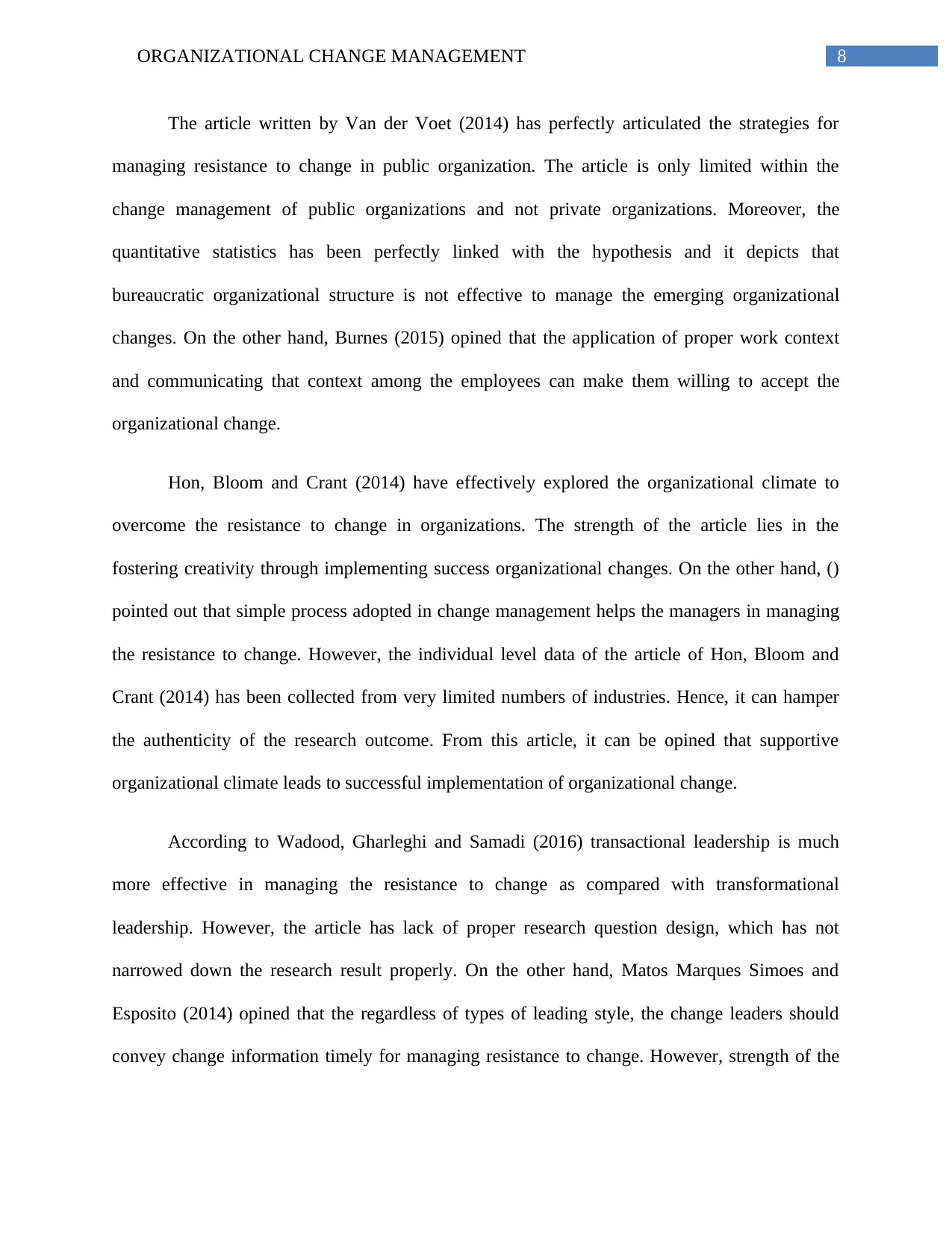
8ORGANIZATIONAL CHANGE MANAGEMENT
The article written by Van der Voet (2014) has perfectly articulated the strategies for
managing resistance to change in public organization. The article is only limited within the
change management of public organizations and not private organizations. Moreover, the
quantitative statistics has been perfectly linked with the hypothesis and it depicts that
bureaucratic organizational structure is not effective to manage the emerging organizational
changes. On the other hand, Burnes (2015) opined that the application of proper work context
and communicating that context among the employees can make them willing to accept the
organizational change.
Hon, Bloom and Crant (2014) have effectively explored the organizational climate to
overcome the resistance to change in organizations. The strength of the article lies in the
fostering creativity through implementing success organizational changes. On the other hand, ()
pointed out that simple process adopted in change management helps the managers in managing
the resistance to change. However, the individual level data of the article of Hon, Bloom and
Crant (2014) has been collected from very limited numbers of industries. Hence, it can hamper
the authenticity of the research outcome. From this article, it can be opined that supportive
organizational climate leads to successful implementation of organizational change.
According to Wadood, Gharleghi and Samadi (2016) transactional leadership is much
more effective in managing the resistance to change as compared with transformational
leadership. However, the article has lack of proper research question design, which has not
narrowed down the research result properly. On the other hand, Matos Marques Simoes and
Esposito (2014) opined that the regardless of types of leading style, the change leaders should
convey change information timely for managing resistance to change. However, strength of the
The article written by Van der Voet (2014) has perfectly articulated the strategies for
managing resistance to change in public organization. The article is only limited within the
change management of public organizations and not private organizations. Moreover, the
quantitative statistics has been perfectly linked with the hypothesis and it depicts that
bureaucratic organizational structure is not effective to manage the emerging organizational
changes. On the other hand, Burnes (2015) opined that the application of proper work context
and communicating that context among the employees can make them willing to accept the
organizational change.
Hon, Bloom and Crant (2014) have effectively explored the organizational climate to
overcome the resistance to change in organizations. The strength of the article lies in the
fostering creativity through implementing success organizational changes. On the other hand, ()
pointed out that simple process adopted in change management helps the managers in managing
the resistance to change. However, the individual level data of the article of Hon, Bloom and
Crant (2014) has been collected from very limited numbers of industries. Hence, it can hamper
the authenticity of the research outcome. From this article, it can be opined that supportive
organizational climate leads to successful implementation of organizational change.
According to Wadood, Gharleghi and Samadi (2016) transactional leadership is much
more effective in managing the resistance to change as compared with transformational
leadership. However, the article has lack of proper research question design, which has not
narrowed down the research result properly. On the other hand, Matos Marques Simoes and
Esposito (2014) opined that the regardless of types of leading style, the change leaders should
convey change information timely for managing resistance to change. However, strength of the
⊘ This is a preview!⊘
Do you want full access?
Subscribe today to unlock all pages.

Trusted by 1+ million students worldwide
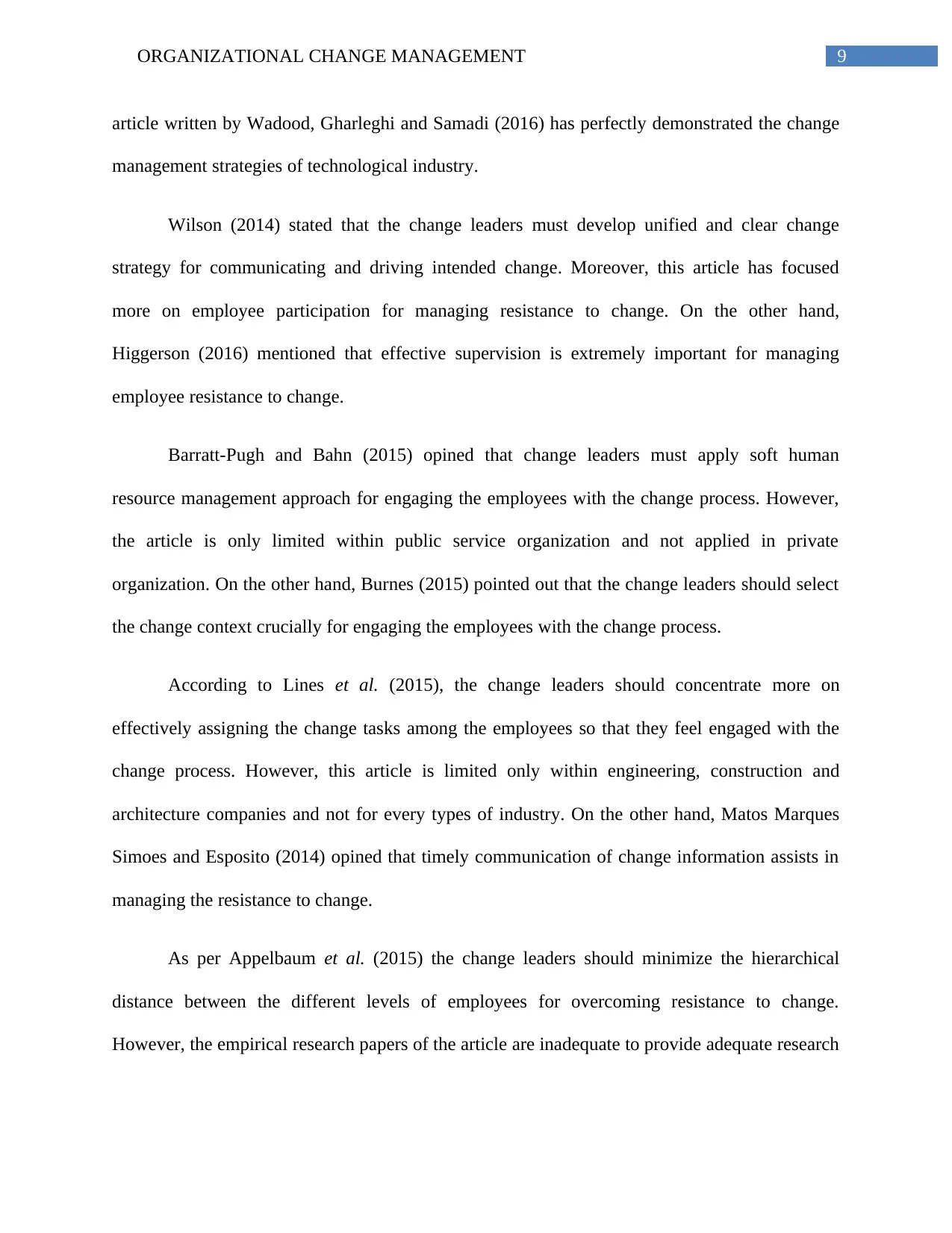
9ORGANIZATIONAL CHANGE MANAGEMENT
article written by Wadood, Gharleghi and Samadi (2016) has perfectly demonstrated the change
management strategies of technological industry.
Wilson (2014) stated that the change leaders must develop unified and clear change
strategy for communicating and driving intended change. Moreover, this article has focused
more on employee participation for managing resistance to change. On the other hand,
Higgerson (2016) mentioned that effective supervision is extremely important for managing
employee resistance to change.
Barratt-Pugh and Bahn (2015) opined that change leaders must apply soft human
resource management approach for engaging the employees with the change process. However,
the article is only limited within public service organization and not applied in private
organization. On the other hand, Burnes (2015) pointed out that the change leaders should select
the change context crucially for engaging the employees with the change process.
According to Lines et al. (2015), the change leaders should concentrate more on
effectively assigning the change tasks among the employees so that they feel engaged with the
change process. However, this article is limited only within engineering, construction and
architecture companies and not for every types of industry. On the other hand, Matos Marques
Simoes and Esposito (2014) opined that timely communication of change information assists in
managing the resistance to change.
As per Appelbaum et al. (2015) the change leaders should minimize the hierarchical
distance between the different levels of employees for overcoming resistance to change.
However, the empirical research papers of the article are inadequate to provide adequate research
article written by Wadood, Gharleghi and Samadi (2016) has perfectly demonstrated the change
management strategies of technological industry.
Wilson (2014) stated that the change leaders must develop unified and clear change
strategy for communicating and driving intended change. Moreover, this article has focused
more on employee participation for managing resistance to change. On the other hand,
Higgerson (2016) mentioned that effective supervision is extremely important for managing
employee resistance to change.
Barratt-Pugh and Bahn (2015) opined that change leaders must apply soft human
resource management approach for engaging the employees with the change process. However,
the article is only limited within public service organization and not applied in private
organization. On the other hand, Burnes (2015) pointed out that the change leaders should select
the change context crucially for engaging the employees with the change process.
According to Lines et al. (2015), the change leaders should concentrate more on
effectively assigning the change tasks among the employees so that they feel engaged with the
change process. However, this article is limited only within engineering, construction and
architecture companies and not for every types of industry. On the other hand, Matos Marques
Simoes and Esposito (2014) opined that timely communication of change information assists in
managing the resistance to change.
As per Appelbaum et al. (2015) the change leaders should minimize the hierarchical
distance between the different levels of employees for overcoming resistance to change.
However, the empirical research papers of the article are inadequate to provide adequate research
Paraphrase This Document
Need a fresh take? Get an instant paraphrase of this document with our AI Paraphraser
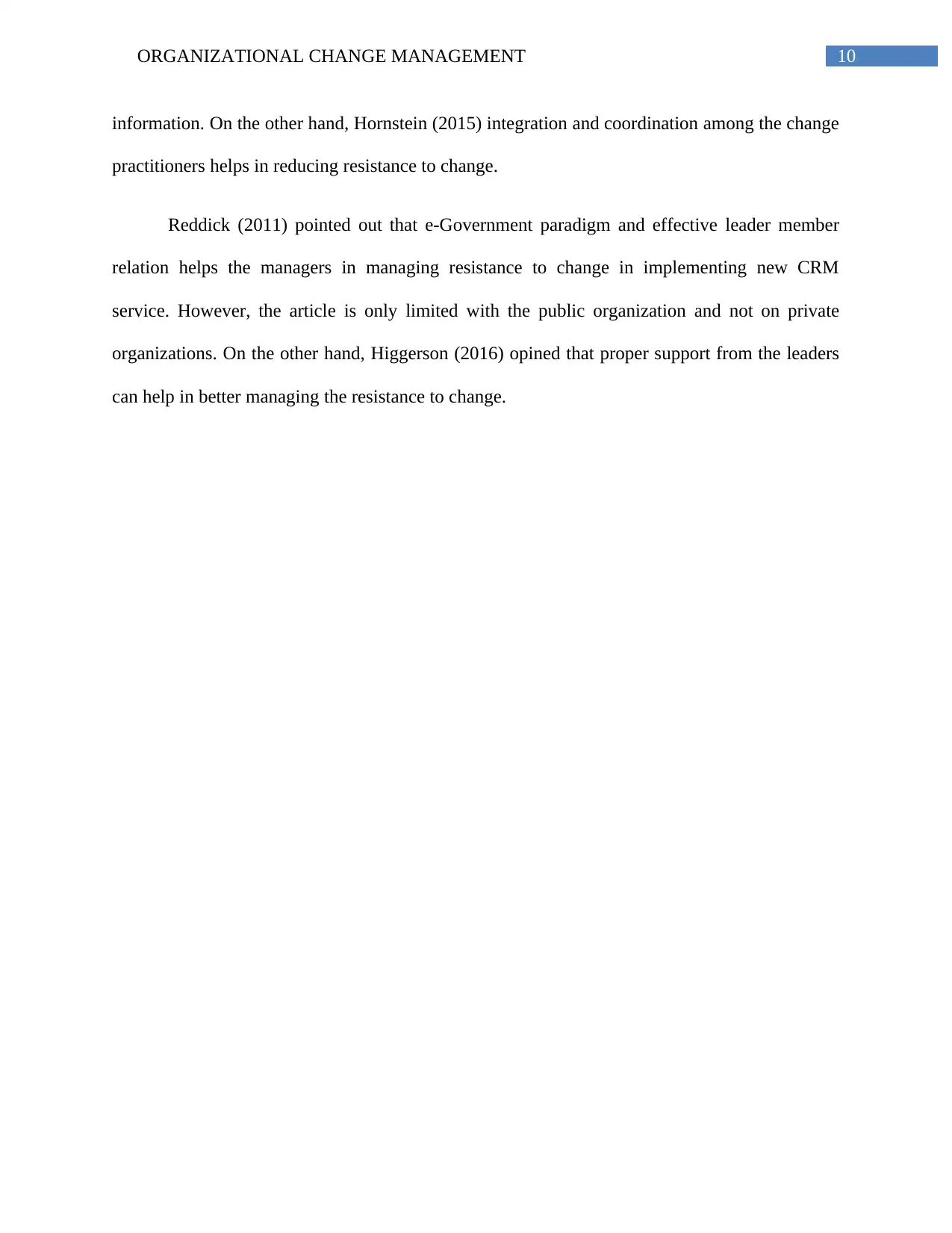
10ORGANIZATIONAL CHANGE MANAGEMENT
information. On the other hand, Hornstein (2015) integration and coordination among the change
practitioners helps in reducing resistance to change.
Reddick (2011) pointed out that e-Government paradigm and effective leader member
relation helps the managers in managing resistance to change in implementing new CRM
service. However, the article is only limited with the public organization and not on private
organizations. On the other hand, Higgerson (2016) opined that proper support from the leaders
can help in better managing the resistance to change.
information. On the other hand, Hornstein (2015) integration and coordination among the change
practitioners helps in reducing resistance to change.
Reddick (2011) pointed out that e-Government paradigm and effective leader member
relation helps the managers in managing resistance to change in implementing new CRM
service. However, the article is only limited with the public organization and not on private
organizations. On the other hand, Higgerson (2016) opined that proper support from the leaders
can help in better managing the resistance to change.
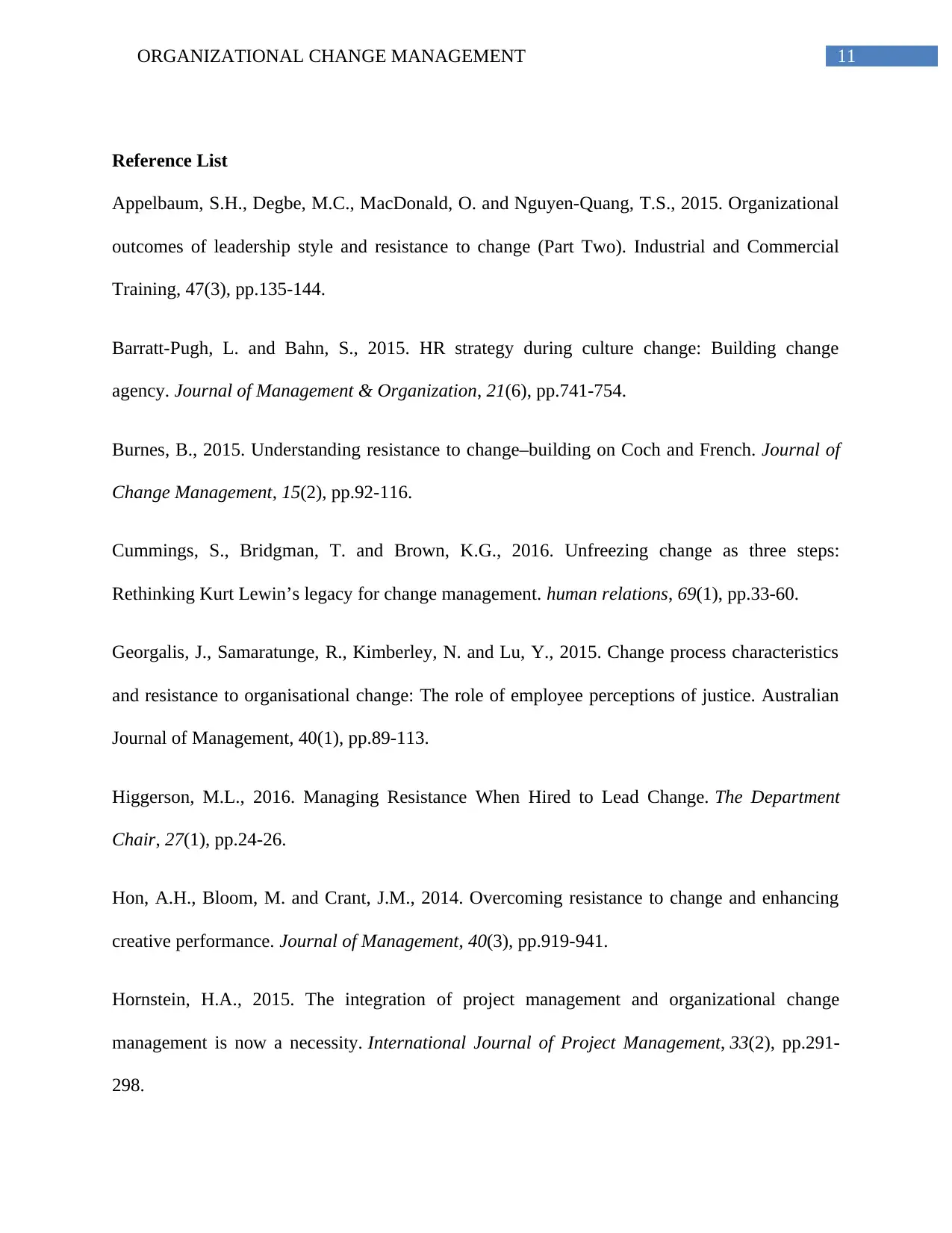
11ORGANIZATIONAL CHANGE MANAGEMENT
Reference List
Appelbaum, S.H., Degbe, M.C., MacDonald, O. and Nguyen-Quang, T.S., 2015. Organizational
outcomes of leadership style and resistance to change (Part Two). Industrial and Commercial
Training, 47(3), pp.135-144.
Barratt-Pugh, L. and Bahn, S., 2015. HR strategy during culture change: Building change
agency. Journal of Management & Organization, 21(6), pp.741-754.
Burnes, B., 2015. Understanding resistance to change–building on Coch and French. Journal of
Change Management, 15(2), pp.92-116.
Cummings, S., Bridgman, T. and Brown, K.G., 2016. Unfreezing change as three steps:
Rethinking Kurt Lewin’s legacy for change management. human relations, 69(1), pp.33-60.
Georgalis, J., Samaratunge, R., Kimberley, N. and Lu, Y., 2015. Change process characteristics
and resistance to organisational change: The role of employee perceptions of justice. Australian
Journal of Management, 40(1), pp.89-113.
Higgerson, M.L., 2016. Managing Resistance When Hired to Lead Change. The Department
Chair, 27(1), pp.24-26.
Hon, A.H., Bloom, M. and Crant, J.M., 2014. Overcoming resistance to change and enhancing
creative performance. Journal of Management, 40(3), pp.919-941.
Hornstein, H.A., 2015. The integration of project management and organizational change
management is now a necessity. International Journal of Project Management, 33(2), pp.291-
298.
Reference List
Appelbaum, S.H., Degbe, M.C., MacDonald, O. and Nguyen-Quang, T.S., 2015. Organizational
outcomes of leadership style and resistance to change (Part Two). Industrial and Commercial
Training, 47(3), pp.135-144.
Barratt-Pugh, L. and Bahn, S., 2015. HR strategy during culture change: Building change
agency. Journal of Management & Organization, 21(6), pp.741-754.
Burnes, B., 2015. Understanding resistance to change–building on Coch and French. Journal of
Change Management, 15(2), pp.92-116.
Cummings, S., Bridgman, T. and Brown, K.G., 2016. Unfreezing change as three steps:
Rethinking Kurt Lewin’s legacy for change management. human relations, 69(1), pp.33-60.
Georgalis, J., Samaratunge, R., Kimberley, N. and Lu, Y., 2015. Change process characteristics
and resistance to organisational change: The role of employee perceptions of justice. Australian
Journal of Management, 40(1), pp.89-113.
Higgerson, M.L., 2016. Managing Resistance When Hired to Lead Change. The Department
Chair, 27(1), pp.24-26.
Hon, A.H., Bloom, M. and Crant, J.M., 2014. Overcoming resistance to change and enhancing
creative performance. Journal of Management, 40(3), pp.919-941.
Hornstein, H.A., 2015. The integration of project management and organizational change
management is now a necessity. International Journal of Project Management, 33(2), pp.291-
298.
⊘ This is a preview!⊘
Do you want full access?
Subscribe today to unlock all pages.

Trusted by 1+ million students worldwide
1 out of 13
Related Documents
Your All-in-One AI-Powered Toolkit for Academic Success.
+13062052269
info@desklib.com
Available 24*7 on WhatsApp / Email
![[object Object]](/_next/static/media/star-bottom.7253800d.svg)
Unlock your academic potential
Copyright © 2020–2025 A2Z Services. All Rights Reserved. Developed and managed by ZUCOL.





